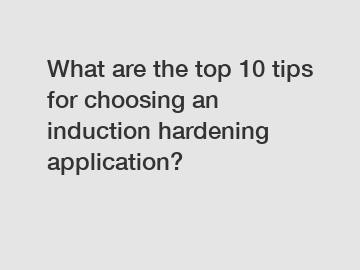What are the top 10 tips for choosing an induction hardening application?
What are the top 10 tips for choosing an induction hardening application?
Induction hardening is a popular heat treatment process used in the manufacturing industry to enhance the surface properties of metal components. It involves selectively heating the surface of a part using high-frequency electrical currents and then rapidly quenching it to increase its hardness and wear resistance. When considering an induction hardening application, several factors need to be considered to ensure optimal results and efficient operations. In this article, we will discuss the top 10 tips for choosing the right induction hardening application.
1. Understand the Material: The first step in selecting an induction hardening application is understanding the material you will be working with. Different materials respond differently to the induction hardening process, so it is crucial to determine the material's composition, microstructure, and desired hardness before proceeding.

2. Analyze the Component: Carefully analyze the component that requires induction hardening. Consider its geometry, size, weight, and specific hardening requirements. This analysis will help you determine the suitable induction hardening equipment and parameters required to achieve the desired results.
3. Consider the Induction Heating System: The choice of induction heating system plays a vital role in the overall hardening process. Consider factors such as the system's power output, frequency range, ability to control and monitor temperature, and compatibility with your unique requirements. Investing in a reliable and efficient induction heating system is essential for quality and consistent results.
4. Optimize the Coil Design: The design of the induction heating coil is critical for effective heat distribution and uniform hardening. Customized coil designs catered to the specific component will ensure optimal heating and quenching, minimizing distortion and maximizing hardness.
5. Quenching Considerations: Induction hardening is typically followed by quenching to rapidly cool the heated component, freezing its hardened microstructure. Different quenching media, such as water, oil, or polymer solutions, provide varying levels of cooling rates and hardness characteristics. Choose the appropriate quenching method that aligns with your desired outcome.
6. Process Control and Monitoring: Implementing a robust process control and monitoring system is crucial for maintaining quality and repeatability in induction hardening. Real-time monitoring of temperature, power output, cycle times, and other variables helps ensure consistent and optimized hardening results.
7. Safety Considerations: Induction hardening involves high temperatures and electrical currents. Ensure adequate safety measures and equipment are in place to protect operators and prevent accidents. Invest in proper training and adhere to safety protocols to create a safe working environment.
8. Cost-effectiveness: While quality and performance are crucial, considering the cost-effectiveness of the induction hardening application is equally important. Evaluate the capital costs, operating costs, and potential return on investment when selecting the right equipment and process parameters.
9. Seek Expert Advice: If you lack experience or face complex hardening requirements, it's advisable to seek expert advice. Consulting with an experienced induction heat treating specialist can help in the selection of equipment, process parameters, and troubleshooting any issues that may arise during the induction hardening process.
10. Continuous Improvement: Induction hardening is a dynamic process that can be optimized further with continuous improvement efforts. Regularly evaluate the process, monitor performance, and identify areas for enhancement. Implementing new technologies, materials, or process improvements can help stay at the forefront of the induction hardening industry.
In conclusion, choosing the right induction hardening application requires careful consideration of several factors, including material properties, component analysis, equipment selection, process control, safety, and cost-effectiveness. By following these top 10 tips, you can ensure optimal results and efficiencies in your induction hardening operations, ultimately leading to enhanced product quality and customer satisfaction.
Contact us to discuss your requirements of induction heater for forging, induction heating forge, high frequency screw rod quenching machine. Our experienced sales team can help you identify the options that best suit your needs.


